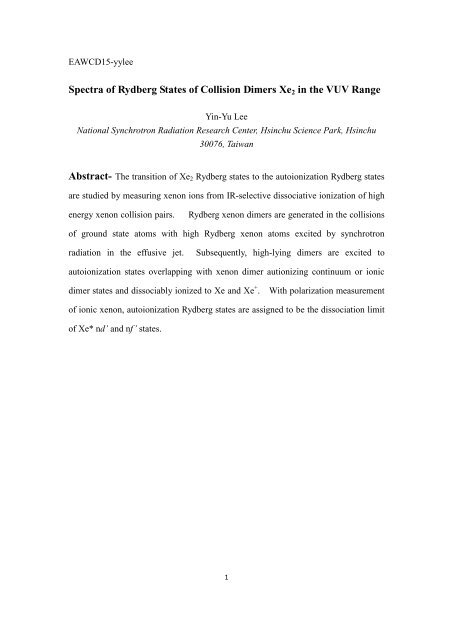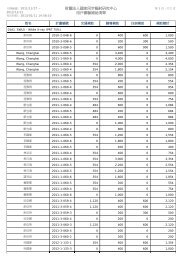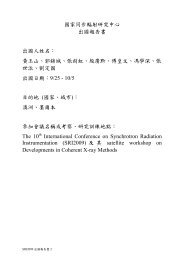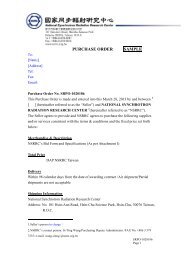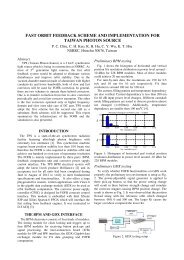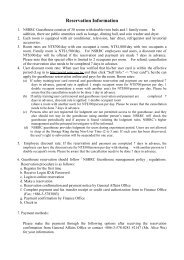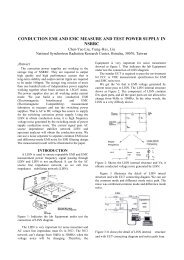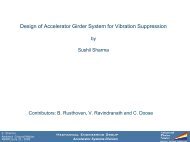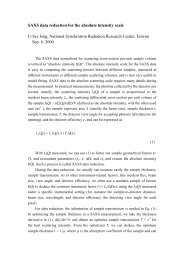Spectra of Rydberg States of Collision Dimers Xe2 in the VUV Range
Spectra of Rydberg States of Collision Dimers Xe2 in the VUV Range
Spectra of Rydberg States of Collision Dimers Xe2 in the VUV Range
You also want an ePaper? Increase the reach of your titles
YUMPU automatically turns print PDFs into web optimized ePapers that Google loves.
EAWCD15-yylee<br />
<strong>Spectra</strong> <strong>of</strong> <strong>Rydberg</strong> <strong>States</strong> <strong>of</strong> <strong>Collision</strong> <strong>Dimers</strong> Xe 2 <strong>in</strong> <strong>the</strong> <strong>VUV</strong> <strong>Range</strong><br />
Y<strong>in</strong>-Yu Lee<br />
National Synchrotron Radiation Research Center, Hs<strong>in</strong>chu Science Park, Hs<strong>in</strong>chu<br />
30076, Taiwan<br />
Abstract- The transition <strong>of</strong> Xe 2 <strong>Rydberg</strong> states to <strong>the</strong> autoionization <strong>Rydberg</strong> states<br />
are studied by measur<strong>in</strong>g xenon ions from IR-selective dissociative ionization <strong>of</strong> high<br />
energy xenon collision pairs.<br />
<strong>Rydberg</strong> xenon dimers are generated <strong>in</strong> <strong>the</strong> collisions<br />
<strong>of</strong> ground state atoms with high <strong>Rydberg</strong> xenon atoms excited by synchrotron<br />
radiation <strong>in</strong> <strong>the</strong> effusive jet.<br />
Subsequently, high-ly<strong>in</strong>g dimers are excited to<br />
autoionization states overlapp<strong>in</strong>g with xenon dimer autioniz<strong>in</strong>g cont<strong>in</strong>uum or ionic<br />
dimer states and dissociably ionized to Xe and Xe + . With polarization measurement<br />
<strong>of</strong> ionic xenon, autoionization <strong>Rydberg</strong> states are assigned to be <strong>the</strong> dissociation limit<br />
<strong>of</strong> Xe* nd’ and nf’ states.<br />
1
<strong>Rydberg</strong> states are <strong>the</strong> excited states next to <strong>the</strong> valance orbitals <strong>in</strong> <strong>the</strong> atoms or<br />
molecules, and energy can be described <strong>in</strong> <strong>Rydberg</strong> equation:[1]<br />
E = T – R(n-) -2<br />
Neutral atomic or molecular <strong>Rydberg</strong> states overlapp<strong>in</strong>g with ionic cont<strong>in</strong>uum are<br />
Autoionization <strong>Rydberg</strong> states (ARS) which have importance <strong>in</strong> understand<strong>in</strong>g <strong>the</strong><br />
<strong>in</strong>teractions between <strong>the</strong> <strong>Rydberg</strong> electron and ionic core. The ARS <strong>of</strong> diatomic<br />
molecules which usually have more rigid structure than polyatomic ones can be<br />
measured by photoionization mass spectroscopy (PIMS), photoelectron spectroscopy<br />
(PES), absorption spectroscopy and some optical techniques.[2] Special k<strong>in</strong>d <strong>of</strong><br />
diatomic molecules are rare gas dimers form<strong>in</strong>g with atom-atom van der Waal’s<br />
attraction which is non chemical-bonded and have unstable ground states and more<br />
stable long-lived excited states. Rare gas dimers are fully occupied with electrons <strong>in</strong><br />
valance shell, and <strong>the</strong>ir autoionization <strong>Rydberg</strong> states are respected to be approxmate<br />
to atomic <strong>Rydberg</strong> series <strong>of</strong> rare gases with typical Fano l<strong>in</strong>e shapes which are<br />
<strong>in</strong>duced <strong>in</strong> <strong>the</strong> <strong>in</strong>teractions <strong>of</strong> discrete and cont<strong>in</strong>uum states above <strong>the</strong> ionic energy <strong>of</strong><br />
<strong>the</strong> Xe + 2 A 2 Σ + 1/2u state.[3-5] Xenon is a much heavier atom <strong>in</strong> <strong>the</strong> rare gas group and<br />
easily forms dimer due to <strong>the</strong> Van der Waal’s mass factor under <strong>the</strong> condition <strong>of</strong> room<br />
temperature. All <strong>the</strong> <strong>Rydberg</strong> states <strong>of</strong> Xe 2 are located <strong>in</strong> <strong>the</strong> <strong>VUV</strong> energy region<br />
and some <strong>of</strong> <strong>the</strong>m are more stable than ground state.<br />
Consequently, <strong>the</strong> xenon<br />
dimers are powerful materials for generat<strong>in</strong>g <strong>the</strong> <strong>VUV</strong> light source <strong>of</strong> laser and lamp<br />
now.[6]<br />
Previous measurements <strong>of</strong> Xe 2 autoioniz<strong>in</strong>g states were studied by one photon<br />
excitation to vic<strong>in</strong>ity <strong>of</strong> ns’ and nd’ xenon atomic states between <strong>the</strong> Xe + ( 2 P 3/2 ) and<br />
Xe + ( 2 P 1/2 ) levels.[7-9]<br />
Some gerade states overly<strong>in</strong>g with ionic layer are<br />
subsequently studied by two-photon excitation.[10-12] But direct survey <strong>of</strong> dimers<br />
<strong>Rydberg</strong> and autoioniz<strong>in</strong>g <strong>Rydberg</strong> states is still problematical attributed to poor<br />
2
Frank-Condon overlap from ground state, competition <strong>of</strong> dissociative reactions, and<br />
optical limitation <strong>in</strong> <strong>VUV</strong> energy region.<br />
Keto’s group presented that <strong>the</strong> collision dimers would be formed <strong>in</strong> energy decay<br />
processes <strong>of</strong> excited xenon atoms collid<strong>in</strong>g with ground state ones and <strong>Rydberg</strong> states<br />
<strong>of</strong> Xe 2 can be studied.[13] To solve <strong>the</strong> problems, we establish an experimental<br />
setup which has effusive jet and photoionization mass spectrometer with synchrotron<br />
radiation used as <strong>the</strong> excit<strong>in</strong>g light source.<br />
Xenon atoms are excited by synchrotron<br />
radiation and <strong>the</strong>n collide with ground state atoms form<strong>in</strong>g excited dimers <strong>in</strong> effusive<br />
beam.<br />
High <strong>Rydberg</strong> states Xe 2 * which are excited to autoionization series by IR<br />
laser follow<strong>in</strong>g with dissociative ionization to have Xe + . Consequently, autoioniz<strong>in</strong>g<br />
states <strong>of</strong> dimers could be deduced by measur<strong>in</strong>g <strong>the</strong> xenon ions.<br />
The vacuum chamber equipped with an effusive nozzle and photoionization mass<br />
spectrometer. Pure xenon gases with back pressure 2-10 torr expanded <strong>in</strong>to vacuum<br />
chamber through effusive beam <strong>in</strong>tersected with synchrotron radiation and <strong>in</strong>frared<br />
light at ion region <strong>in</strong> mass spectrometer.<br />
Synchrotron radiation light <strong>in</strong> vacuum-UV<br />
energy region was separated by a monochromator equipped with a cyl<strong>in</strong>drical golden<br />
grat<strong>in</strong>g <strong>in</strong> resolv<strong>in</strong>g power E/ΔE = 20000 at 10 eV with <strong>the</strong> entrance and exit slit <strong>of</strong> 50<br />
and 100 μm. Xenon atoms are selectively excited to ns, nd, ns’ and nd’ atomic<br />
<strong>Rydberg</strong> states <strong>in</strong> <strong>the</strong> wave number range <strong>of</strong> 85000-97000 cm -1 , respectively.[14]<br />
The excited atoms collide with ground state xenons construct<strong>in</strong>g <strong>the</strong> high <strong>Rydberg</strong><br />
xenon dimer states on <strong>the</strong> top <strong>of</strong> effusive jet. Near <strong>in</strong>frared light generated from a<br />
cont<strong>in</strong>uous wave Ti-sapphire laser (Coherent 899-21 and <strong>Spectra</strong>-Physics, Tsunami)<br />
pumped by an 532 nm Nd:YAG laser (<strong>Spectra</strong>-Physics, Millenia) is used as ioniz<strong>in</strong>g<br />
dissociation source <strong>of</strong> xenon collision pairs.<br />
The output wavelength is tuned by a<br />
birefr<strong>in</strong>gent filter yield<strong>in</strong>g <strong>the</strong> spectral resolution <strong>of</strong> 0.25 cm -1 <strong>in</strong> <strong>the</strong> scann<strong>in</strong>g range <strong>of</strong><br />
11800-13700 cm -1 <strong>of</strong> Coherent 899-21 and resolution about 1.5 cm -1 <strong>in</strong> <strong>the</strong> scann<strong>in</strong>g<br />
3
ange <strong>of</strong> 13300-14200 cm -1 <strong>of</strong> Tsunami laser for <strong>the</strong> present work.<br />
The absolute<br />
position <strong>of</strong> laser wavelength is measured by a wavemeter (EXFO 4550) with accuracy<br />
<strong>of</strong> 0.02 cm -1 . The laser output is l<strong>in</strong>early polarized and rotatable with a half-wave<br />
Fresnal rhomb polarizer.<br />
The IR laser beam counter-propagated with synchrotron<br />
radiation beam was s<strong>of</strong>tly focused to a spot diameter 0.5 mm <strong>in</strong> <strong>the</strong> mass spectrometer<br />
extraction region with electronic filed ~10V/cm.<br />
Ions xenon produced from<br />
ionization dissociation were detected with a quadrupole mass filter set mass = 131.<br />
The selected ions were collided with a diode applied high voltage for conversion to<br />
electrons <strong>in</strong> a channeltron. The output signal current was amplified and <strong>the</strong>n counted<br />
with a counter.<br />
The ground states <strong>of</strong> xenon dimer is X 1 Σ + g (0 + g ) with an electronic configuration<br />
(σ g 5s) 2 (σ u 5s) 2 (σ g 5p) 2 (π g 5p) 4 (π u 5p) 4 (σ u 5p) 2 , a shallow potential energy well and a large<br />
<strong>in</strong>termolecular distance. The removal <strong>of</strong> one electron from each <strong>of</strong> <strong>the</strong> valance<br />
molecular orbitals lead to six electronic states for Xe + 2 A 2 +<br />
Σ 1/2u , B 2 Π 3/2g , B 2 Π 1/2g , C<br />
2 Π 3/2u , C 2 Π 1/2u , and D 2 Σ + 1/2g ; <strong>the</strong>se states are displayed with <strong>the</strong> Hund’s rule notation<br />
[ 2S+1 Λ Ωg/u ] <strong>in</strong> which Ω denotes <strong>the</strong> total electronic angular momentum with Λ def<strong>in</strong>ed<br />
as <strong>the</strong> total orbital angular momentum.<br />
The symbol Ω g/u is suggested as a<br />
well-def<strong>in</strong>ed quantum number than Λ and Σ (projection <strong>of</strong> electron sp<strong>in</strong> S along <strong>the</strong><br />
<strong>in</strong>ternuclear axis).<br />
The lowest four xenon dimmer ion electronic states correspond to<br />
<strong>the</strong> Xe( 1 S 0 )+Xe + ( 2 P 3/2 ) limit whereas <strong>the</strong> rema<strong>in</strong><strong>in</strong>g two dissociate to Xe( 1 S 0 )+<br />
Xe + ( 2 P 1/2 ) state.<br />
Xe 2 Rydbreg states converg<strong>in</strong>g to six electronic ion states are<br />
appropriately treated as an ionic states and a <strong>Rydberg</strong> electron state.[5] Congestion<br />
<strong>of</strong> autoionization <strong>Rydberg</strong> states above <strong>the</strong> first ionic state ly<strong>in</strong>g with ionic cont<strong>in</strong>uum<br />
dissociate to Xe( 1 S 0 ) + Xe(nl[K] J , n≧7) or Xe(nl’[K] J , n≧7) limit.<br />
The generation <strong>of</strong> high <strong>Rydberg</strong> xenon dimers with <strong>the</strong> excitation <strong>of</strong> xenon<br />
atomic levels above 85000 cm -1 with<strong>in</strong> <strong>the</strong> collision processes on <strong>the</strong> top <strong>of</strong> effusive<br />
4
jet, <strong>the</strong> signal xenon ions are monitored <strong>in</strong> m/z =131 and arise from <strong>the</strong> 8s[3/2] 1 state<br />
(90932.432 cm -1 ) with <strong>in</strong>frared dissociative ionization. The spectra <strong>of</strong> ion signal are<br />
shown <strong>in</strong> FIG. 2 <strong>in</strong> which <strong>the</strong> horizontal scale is <strong>in</strong>frared light energy.<br />
Despite <strong>the</strong><br />
transition <strong>of</strong> <strong>Rydberg</strong> to autoionization states are <strong>in</strong> <strong>the</strong> present work, it should be<br />
noted that atomic even-parity autoionizaiton <strong>Rydberg</strong> states and dimer <strong>Rydberg</strong> states<br />
to ionic states are possibly <strong>in</strong>cluded superimpos<strong>in</strong>g on <strong>the</strong> xenon ionic cont<strong>in</strong>uum<br />
level.<br />
Two-photon resonant-enhanced excitation <strong>of</strong> xenon atoms are <strong>in</strong>dicated by green<br />
ticks whereas <strong>the</strong> prime means <strong>the</strong> series converg<strong>in</strong>g to Xe + ( 2 P 1/2 ) limit. Xenon<br />
atoms are step-wise pumped by synchrotron radiation s<strong>in</strong>gle-photon excitation to nd<br />
and ns states where J is equal to 1, and subsequently excited to even-parity np’[3/2] 2,1 ,<br />
np’[1/2] 1,0 and nf’[5/2] 2 states.[14] Here <strong>the</strong> <strong>in</strong>tense atomic peaks are assigned np’<br />
series because <strong>of</strong> good excitation cross section <strong>of</strong> s’p’ transition.<br />
These series<br />
above <strong>the</strong> IE <strong>of</strong> xenon spread<strong>in</strong>g over <strong>the</strong> ionic state with specific description <strong>of</strong> Fano<br />
formula are autoionizaiton <strong>Rydberg</strong> states and consequently could be measured by<br />
mass spectrometer.<br />
The observations <strong>of</strong> <strong>the</strong> peaks with FWHM ~5cm -1 <strong>in</strong> FIG. 4 via <strong>in</strong>termediate<br />
atomic Xe*5p 5 12s[3/2] 1 state are marked <strong>in</strong> Arabic numerals and assigned to be <strong>the</strong><br />
<strong>Rydberg</strong> states <strong>in</strong> <strong>the</strong> energy region <strong>of</strong> 83700-86000 cm -1 . Their existences refer to<br />
<strong>the</strong> relaxation <strong>of</strong> collision pairs to <strong>the</strong> relatively stable <strong>Rydberg</strong> states <strong>of</strong> xenon<br />
dimers.[15] These <strong>Rydberg</strong> states are excited to <strong>the</strong> autoioniz<strong>in</strong>g levels coupl<strong>in</strong>g<br />
with <strong>the</strong> Xe + 2 B 2 Π 1/2g state:<br />
Xe ( 1 S 0 ) + hυ (SR,<strong>VUV</strong>) Xe**<br />
Xe** + Xe → Xe 2 **<br />
Xe 2 ** → Xe 2 * + hυ (em, IR)<br />
Xe 2 * + hυ (laser, IR) → Xe + + Xe<br />
5
or<br />
Xe ( 1 S 0 ) + hυ (SR,<strong>VUV</strong>) → Xe**<br />
Xe** → Xe* + hυ (em, IR)<br />
Xe* + Xe → Xe 2 *<br />
Xe 2 * + hυ (laser, IR) → Xe + + Xe<br />
Both atomic and collision dimer emission can occur <strong>in</strong> <strong>the</strong> decay processes.<br />
Nonradiative path are possibly <strong>in</strong>cluded <strong>in</strong> <strong>the</strong> reaction.<br />
These bands <strong>in</strong> which <strong>the</strong><br />
energy are determ<strong>in</strong>ed <strong>in</strong> <strong>the</strong> difference from Xe + ( 2 P 3/2 ) at 97833.787 cm -1 and <strong>the</strong><br />
marked from high IR to low IR energy ( band energy from low to high). These<br />
results could be consistent with previous studies <strong>of</strong> absorption, laser-<strong>in</strong>duced<br />
fluorescence spectra, and <strong>the</strong>oretical calculation.[16-19]<br />
In FIG. 4 band 1-13 <strong>in</strong> <strong>the</strong><br />
energy region <strong>of</strong> 83700-85070 cm -1 are covered <strong>in</strong> <strong>the</strong> absorption spectra[16], and<br />
subsequently band 2 is assigned to 0 u<br />
+<br />
state which dissociates to Xe( 1 S 0 ) +<br />
Xe*5d[3/2] 1 .[18]<br />
Band 13 is 0 u + or 1 u states which has good agreement with LIF<br />
experimental results, and band 11 is compatible with <strong>the</strong>oretical calculation.[19]<br />
O<strong>the</strong>rs are completely new observed <strong>Rydberg</strong> states which are not measured<br />
previously due to poor Frank-Condon overlap from dimer ground states.<br />
The <strong>in</strong>tense bands with FWHM>10 cm -1 and pair<strong>in</strong>g structure <strong>in</strong> FIG. 3 and 4 are<br />
labeled by Roman numbers and listed <strong>in</strong> Table I. These bands appear above <strong>the</strong><br />
energy <strong>of</strong> atomic states 8s[3/2] 1 (90932.432 cm -1 ) states where <strong>the</strong> energy is slightly<br />
higher than <strong>the</strong> ionic threshold <strong>of</strong> xenon dimers.[5] These bands are excluded from<br />
xenon atomic l<strong>in</strong>es because <strong>of</strong> no fitt<strong>in</strong>g energy difference from <strong>the</strong>se atomic states<br />
and unseriously polarization effect.<br />
These band have Fano l<strong>in</strong>e pr<strong>of</strong>ile and are<br />
<strong>in</strong>dentified as <strong>the</strong> transitions <strong>of</strong> <strong>Rydberg</strong> states to autoionzation <strong>Rydberg</strong> states. The<br />
signals are from this proposed processes:<br />
Xe + hυ (SR,<strong>VUV</strong>) → Xe**<br />
6
Xe** + Xe → Xe 2 **<br />
Xe 2 ** + hυ (IR) → Xe 2 ***(ARS)<br />
→ Xe*(ARS)+Xe → Xe + + Xe<br />
The most <strong>in</strong>tense signals are observed via <strong>the</strong> atomic states 7s’[1/2]1 and 10d[1/2] 1 at<br />
<strong>the</strong> energy <strong>of</strong> 95800.584 and 95912.880 cm -1 , respectively.<br />
Band I and IV at <strong>the</strong><br />
position 13937 and 13476.4 cm -1 vary with weaker horizontal and vertical polariz<strong>in</strong>g<br />
effect, and band III with broad shape has no obvious polarization dependence.<br />
In<br />
contrast band VII at 12245.2 cm -1 with extensity quantity differs apparently with light<br />
polarization. The bands V, VI, and VIII have and pair<strong>in</strong>g structure <strong>in</strong> which <strong>the</strong><br />
separation <strong>of</strong> doubly pairs is about 30 cm -1 . The lower energy items reveal <strong>the</strong> more<br />
unambiguously <strong>in</strong>tense variety <strong>of</strong> laser polarization than <strong>the</strong> higher ones, so <strong>the</strong><br />
vibrational progressions are excluded <strong>in</strong> this case due to <strong>the</strong> polarization dependence<br />
<strong>of</strong> laser light.<br />
Based on <strong>the</strong> results <strong>of</strong> Lipson and his co-workers’ works, <strong>the</strong>y show<br />
that <strong>the</strong> spectra <strong>of</strong> Xe 2 autoioniz<strong>in</strong>g <strong>Rydberg</strong> states above <strong>the</strong> adiabatic IE near <strong>the</strong><br />
dissociation limit <strong>of</strong> atomic 4f states are with evident polarization effect. These<br />
bands are assigned as autoionization <strong>Rydberg</strong> states comply<strong>in</strong>g with Lipson’s<br />
exposition.[11,12]<br />
Despite <strong>the</strong> <strong>in</strong>itial collision dimer states are generated via various xenon <strong>Rydberg</strong><br />
states <strong>in</strong> which energy range from 90000 to 97000 cm -1 , <strong>the</strong>ir ionic signal from IR<br />
excitation are analogous with similar FWHM. It is considered that <strong>the</strong> relaxation<br />
processes occur on <strong>the</strong> top <strong>of</strong> <strong>the</strong> effusive beam and consequently collision pairs<br />
quench to a lower and more stable state.<br />
This assumption <strong>of</strong> <strong>the</strong> same <strong>in</strong>itial state is<br />
<strong>in</strong> agreement with <strong>the</strong> collisional energy transfer procedures <strong>of</strong> <strong>the</strong> xenon <strong>Rydberg</strong><br />
states <strong>in</strong> Museur’s work.[15] The band width represent <strong>the</strong> <strong>in</strong>itial state overlap with<br />
xenon ionic states A 2 Σ + 1/2u and have strong <strong>in</strong>tensity via 7s’[1/2] 1 state due to <strong>the</strong> 2 P 1/2<br />
ionic core <strong>in</strong>terference. This <strong>in</strong>dicates that <strong>the</strong>se ARS converge to <strong>the</strong> Xe + 2 C 2 Π 1/2u<br />
7
electronic states correspond<strong>in</strong>g to <strong>the</strong> Xe + ( 2 P 1/2 ) + Xe( 1 S 0 ) limit.<br />
The appearance <strong>of</strong><br />
<strong>the</strong> xenon dimer signals at <strong>the</strong> atomic states 8s[3/2] 1 <strong>in</strong> which <strong>the</strong> energy is 90932.432<br />
cm -1 . This energy range <strong>of</strong> upper states is slightly lower than <strong>the</strong> 90932.432 cm -1<br />
add<strong>in</strong>g <strong>the</strong> IR energy and locate <strong>in</strong> <strong>the</strong> energy region <strong>of</strong> 103000-110000 cm -1 . The<br />
upper dimer states have predom<strong>in</strong>ant dissociative ionization with IR selective<br />
excitation and assumed to have weak <strong>in</strong>teractions with <strong>the</strong> dimer ionic Σ and Π states.<br />
This <strong>in</strong>fers that <strong>the</strong> f<strong>in</strong>al autoionization states could be <strong>the</strong> Δ or Φ state which<br />
<strong>in</strong>dicates <strong>the</strong> dissociation limit related to xenon nd’ or nf’ levels consist<strong>in</strong>g <strong>of</strong> δ and φ<br />
components. These ARS are assigned near <strong>the</strong> dissociation limit Xe*5-6f’ ad 7-14d’<br />
accord<strong>in</strong>g to <strong>the</strong> energy population. The broad band width is attributed to <strong>the</strong> factors<br />
<strong>of</strong> lifetime <strong>of</strong> upper states, Frank-Codon transition from <strong>Rydberg</strong>, and etc.<br />
Xenon atoms are excited to one specific J states by high resolution synchrotron<br />
radiation with horizontal direction.<br />
In this excitation energy range, every atomic<br />
states can be separated well. After collid<strong>in</strong>g process, dimers <strong>Rydberg</strong> states kept <strong>the</strong><br />
orig<strong>in</strong>al characteristics from <strong>Rydberg</strong> xenon atomic states.<br />
The transitions from<br />
<strong>the</strong>se ARS with specific polarization could be <strong>in</strong>duced or reduced to upper ARS by<br />
polarized laser light.<br />
We studied <strong>the</strong> Xe 2 <strong>Rydberg</strong> and autoiomization <strong>Rydberg</strong> states from IR<br />
excitation <strong>of</strong> collision dimmers. The resolution <strong>in</strong> our spectrum is determ<strong>in</strong>ed by <strong>the</strong><br />
IR laser which has narrow l<strong>in</strong>e width about 0.2 cm -1 and <strong>the</strong> detective problems are<br />
resolved us<strong>in</strong>g MS. Synchrotron radiation gives good <strong>VUV</strong> light source which have<br />
high resolution with a monochromator.<br />
This setup successfully resolves optical<br />
problems and measures <strong>the</strong> <strong>Rydberg</strong> states and ARS <strong>in</strong> this work.<br />
8
References<br />
[1] G. Herzberg, Ann. Rev. Phys. Chem. 38, 27 (1987)<br />
[2]Vacuum Ultraviolet Photoionization and Photodissociaiton <strong>of</strong> molecules and<br />
clusters, edited by C. Y. Ng (World Scientific, 1991)<br />
[3] U. Fano, Phys. Rev. 124, 1866 (1961)<br />
[4] O. Zehnder et al, J. Chem. Phys. 128, 234306 (2008)<br />
[5] R. S. Mulliken, J. Chem. Phys. 52, 5170 (1970)<br />
[6] M. Salvermoser and D. E. Murnick, Appl. Phys. Lett. 83, 1932 (2003)<br />
[7] C. Y. Ng et al., J. Chem. Phys. 65, 4327 (1976)<br />
[8] P. M. Dehmer, and S. T. Pratt, J. Chem. Phys. 75, 5265 (1981)<br />
[9] K. Norwood, G. Luo, and C. Y. Ng, J. Chem. Phys. 90, 4689 (1989)<br />
[10] S. T. Pratt, P. M. Dehmer, and J. L. Dehmer, Chem. Phys. Lett. 165, 131 (1990)<br />
[11] X. K. Hu, et al., J. Chem. Phys. 109, 3944 (1998)<br />
[12] X. K. Hu et al., Chem. Phys. Lett. 353, 213 (2002)<br />
[13] N. Böwer<strong>in</strong>g, T. D. Raymond, and J. W. Keto, Phys. Rev. Lett. 52, 1880 (1984)<br />
[14] NIST Atomic <strong>Spectra</strong> Database (version 4.0), [Onl<strong>in</strong>e]. Available:<br />
http://physics.nist.gov/asd (2010)<br />
[15] L. Museur et al., J. Chem. Phys. 101, 10 548 (1994)<br />
[16] M. C. Castex, Chem. Phys. 5, 448 (1974)<br />
[17]K. Tsukiyama and T. Kasuya, J. Mol. Spectrosc. 151, 312 (1992)<br />
[18]D. M. Mao et al, J. Mol. Spec. 181, 435 (1997)<br />
[19] C. Jon<strong>in</strong> and F. Spiegelmann, J. Chem. Phys. 117, 3059 (2002)<br />
9
Table I.<br />
The energy and FWHM <strong>of</strong> Xe 2 autoionization <strong>Rydberg</strong> states.<br />
Figure Captions<br />
FIG. 1 Energy diagram <strong>of</strong> xenon atomic <strong>Rydberg</strong>, dimer <strong>Rydberg</strong>, and ionic states.<br />
Here <strong>the</strong> xenon atoms are excited to <strong>Rydberg</strong> states and <strong>the</strong>n collide with neutral<br />
atoms to form <strong>Rydberg</strong> dimers.<br />
These high ly<strong>in</strong>g dimers are excited to<br />
autoionizaiton <strong>Rydberg</strong> states or shallow ionic states and ionizatively dissociate to<br />
Xe + and Xe.<br />
FIG. 2 <strong>Spectra</strong> <strong>of</strong> IR selective <strong>Rydberg</strong> states form<strong>in</strong>g via Xe*7s’[1/2] 1 to<br />
autoionization <strong>Rydberg</strong> transition <strong>of</strong> xenon dimers by measur<strong>in</strong>g Xe + signals from<br />
ARS dissociative-ionization to Xe + + Xe <strong>in</strong> <strong>the</strong> IR energy region <strong>of</strong> 11800-13500 cm -1 .<br />
The Fig. 2(a) show that <strong>the</strong> horizontal -polarized SR light excitation <strong>of</strong> atoms and<br />
horizontal-polarized laser excitation <strong>of</strong> Xe 2 <strong>Rydberg</strong> states, and <strong>the</strong> (b) are<br />
horizontal-polarized SR light and vertical -polarized laser layout.<br />
FIG.3 <strong>Spectra</strong> <strong>of</strong> IR selective <strong>Rydberg</strong> states form<strong>in</strong>g via Xe*7s’[1/2] 1 to<br />
autoionization <strong>Rydberg</strong> transition <strong>of</strong> xenon dimers by measur<strong>in</strong>g Xe + signals from<br />
ARS dissociative-ionization to Xe + + Xe <strong>in</strong> <strong>the</strong> IR energy region <strong>of</strong> 13300-14200 cm -1 .<br />
The Fig. 2(a) show that <strong>the</strong> horizontal -polarized SR light excitation <strong>of</strong> atoms and<br />
horizontal-polarized laser excitation <strong>of</strong> Xe 2 <strong>Rydberg</strong> states, and <strong>the</strong> (b) are<br />
horizontal-polarized SR light and vertical -polarized laser layout.<br />
FIG. 4 <strong>Spectra</strong> <strong>of</strong> IR selective Xe 2 <strong>Rydberg</strong> states form<strong>in</strong>g via Xe*12s[3/2] 1 to ARS<br />
and ionic states transition by measur<strong>in</strong>g Xe + signals from dissociative-ionization to<br />
Xe + + Xe limit <strong>in</strong> <strong>the</strong> IR energy region <strong>of</strong> 11800-14200 cm -1 . The Xe 2 <strong>Rydberg</strong><br />
10
states signals are labled with blue bar, and <strong>the</strong>ir positions can be deduced by <strong>the</strong><br />
difference from E[Xe + ( 2 P 3/2 )] and IR energy.<br />
The red marks are <strong>the</strong> peaks <strong>of</strong><br />
autoionization <strong>Rydberg</strong> states.<br />
11
Table I.<br />
The energy and FWHM <strong>of</strong> Xe 2 autoionization <strong>Rydberg</strong> states.<br />
Band<br />
IR Energy<br />
(cm -1 )<br />
Appearance Energy<br />
(cm -1 ) & State<br />
Total Energy<br />
(cm -1 )<br />
FWHM<br />
(cm -1 )<br />
Nearest<br />
State<br />
I 13937<br />
5d’[3/2] 1<br />
93618.24<br />
107555 33 14d’<br />
II 13837<br />
III 13766<br />
7s’[1/2] 1<br />
95800.584<br />
7d[1/2] 1<br />
92128.287<br />
109638 15 <br />
105894 85 9d’<br />
IV 13476.4<br />
8s[3/2] 1<br />
90932.432<br />
104408 14.3 8d’<br />
V<br />
13030.4 8s[3/2] 1 103920.2 15.6<br />
12997.8 90932.432 103962.8 18.5<br />
5f’<br />
VI<br />
12632,.5 8s[3/2] 1 103564.9 15.5<br />
12661.4 90932.432 103593.8 18.0<br />
7d’<br />
VII 12245.2<br />
5d’[3/2] 1<br />
93618.24<br />
105863.3 15.2 9d’<br />
VIII<br />
12098.2 7d[1/2] 1 104226.5 13.2<br />
12127.8 92128.287 104256.1 16.6<br />
6f’<br />
12
FIG1. Energy diagram <strong>of</strong> xenon atomic <strong>Rydberg</strong>, dimer <strong>Rydberg</strong>, and ionic states.<br />
Here <strong>the</strong> xenon atoms are excited to <strong>Rydberg</strong> states and <strong>the</strong>n collide with neutral<br />
atoms to form <strong>Rydberg</strong> dimers.<br />
These high ly<strong>in</strong>g dimers are excited to<br />
autoionizaiton <strong>Rydberg</strong> states or shallow ionic states and ionizatively dissociate to<br />
Xe + and Xe.<br />
13
FIG2.<br />
<strong>Spectra</strong> <strong>of</strong> IR selective <strong>Rydberg</strong> states form<strong>in</strong>g via Xe*7s’[1/2] 1 to<br />
autoionization <strong>Rydberg</strong> transition <strong>of</strong> xenon dimers by measur<strong>in</strong>g Xe + signals from<br />
ARS dissociative-ionization to Xe + + Xe <strong>in</strong> <strong>the</strong> IR energy region <strong>of</strong> 11800-13500 cm -1 .<br />
The Fig. 2(a) show that <strong>the</strong> horizontal -polarized SR light excitation <strong>of</strong> atoms and<br />
horizontal-polarized laser excitation <strong>of</strong> Xe 2 <strong>Rydberg</strong> states, and <strong>the</strong> (b) are<br />
horizontal-polarized SR light and vertical -polarized laser layout.<br />
14
(a)<br />
FIG. 3 <strong>Spectra</strong> <strong>of</strong> IR selective <strong>Rydberg</strong> states form<strong>in</strong>g via Xe*7s’[1/2] 1 to<br />
autoionization <strong>Rydberg</strong> transition <strong>of</strong> xenon dimers by measur<strong>in</strong>g Xe + signals from<br />
ARS dissociative-ionization to Xe + + Xe <strong>in</strong> <strong>the</strong> IR energy region <strong>of</strong> 13300-14200 cm -1 .<br />
The Fig. 2(a) show that <strong>the</strong> horizontal -polarized SR light excitation <strong>of</strong> atoms and<br />
horizontal-polarized laser excitation <strong>of</strong> Xe 2 <strong>Rydberg</strong> states, and <strong>the</strong> (b) are<br />
horizontal-polarized SR light and vertical -polarized laser layout.<br />
(b)<br />
(a)<br />
15
FIG. 4 <strong>Spectra</strong> <strong>of</strong> IR selective Xe 2 <strong>Rydberg</strong> states form<strong>in</strong>g via Xe*12s[3/2] 1 to ARS or<br />
ionic states transition by measur<strong>in</strong>g Xe + signals from dissociative-ionization to Xe + +<br />
Xe limit <strong>in</strong> <strong>the</strong> IR energy region <strong>of</strong> 11800-14200 cm -1 . The Xe 2 <strong>Rydberg</strong> states<br />
signals are labled with blue bar, and <strong>the</strong>ir positions can be deduced by <strong>the</strong> difference<br />
from E[Xe + ( 2 P 3/2 )] and IR energy. The red marks are <strong>the</strong> peaks <strong>of</strong> autoionization<br />
<strong>Rydberg</strong> states.<br />
16


